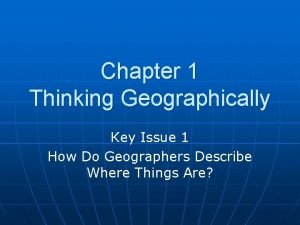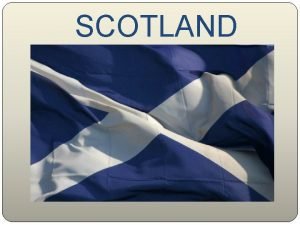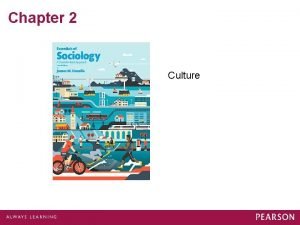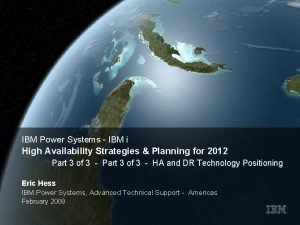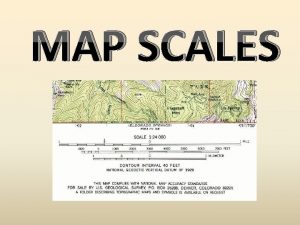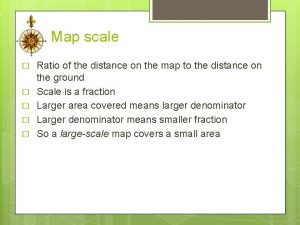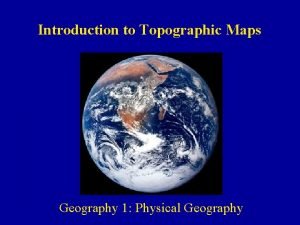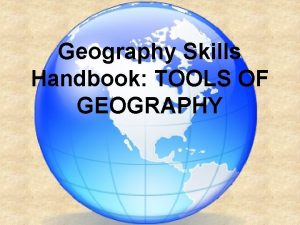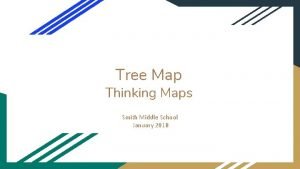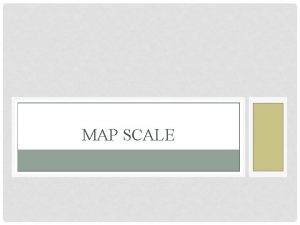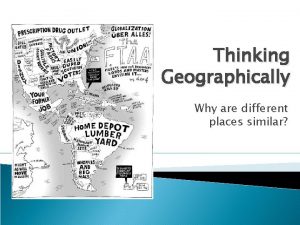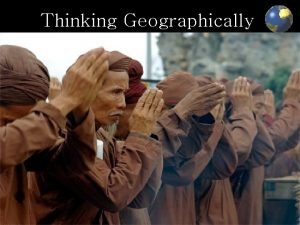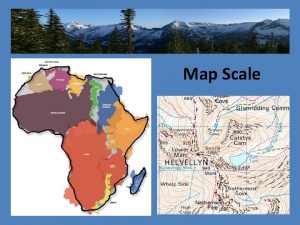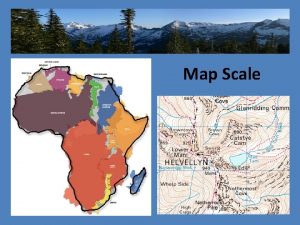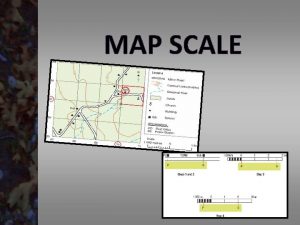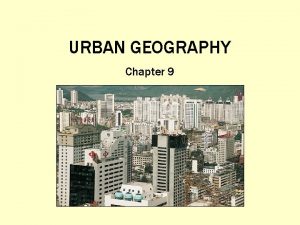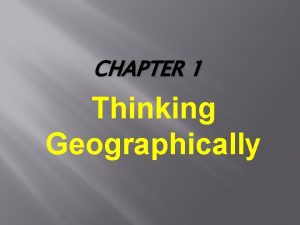THINKING GEOGRAPHICALLY Chapter 1 Map Scale 3 types















- Slides: 15

THINKING GEOGRAPHICALLY Chapter 1

Map Scale • 3 types of scale: • Fractional/Ratio-1/24, 000 or 1: 24, 000 means 1 inch on the map represents 24, 000 inches on the ground • Written: 1 inch equals one mile • Bar - • Scale examples • Neighborhood maps, world maps, country maps all have different scales • The scale is determined by the amount of detail shown in a map • Neighborhood maps will have the largest scale, World maps have the smallest scale

Scale Differences: Maps of Florida

Projection • Since the earth is a 3 D object and a map is a 2 D object, maps will have distortions • This leads to distortion • Shape, distance, relative size, direction • Types of projections • Robinson, Mercator, Mollweide, Sinusoidal, Goode homolosine, • Robinson is best to show size of the oceans • Mercator has least distortion in shape and direction. Grossly distorted near poles


How Geographers Address Location • Contemporary Tools • GIS- layered data to show patterns and relationships (Ian Mc. Harg) • Remote sensing- Satellites that record and map the Earth (mostly environmental but helps with monitoring urban sprawl) • GPS- Precise location provided by satellites (navigation)

Uniqueness of Places and Regions • Place: Unique location of a feature • Place names- Lakeland (toponym). Can be named for several reasons • Site- physical character like climate, water, soil, vegetation. • Situation-location to other places. Singapore is a good example. • Mathematical location- GPS coordinates • Greenwich, England • Latitude and longitude provide location • Latitudes are calculated by the sun whereas longitudes are man made • East of international dateline-ahead • West of international dateline-behind

World Geographic Grid Fig. 1 -8: The world geographic grid consists of meridians of longitude and parallels of latitude. The prime meridan (0º) passes through Greenwich, England.

World Time Zones Fig. 1 -9: The world’s 24 standard time zones are often depicted using the Mercator projection.

Uniqueness of Places and Regions • Regions: Areas of unique characteristics • Cultural landscape- regions have distinct characteristics because of social and physical processes and the Earth is shaped by these relationships. • Types of regions- Vernacular, Formal and Functional • Regional integration of culture -Care about/care for help explain why places on the Earth are unique • Cultural ecology-Culture effects the environment • Possibilism versus Environmental determinism

Formal and Functional Regions Fig. 1 -11: The state of Iowa is an example of a formal region; the areas of influence of various television stations are examples of functional regions.

Vernacular Regions Fig. 1 -12: A number of factors are often used to define the South as a vernacular region, each of which identifies somewhat

Physical Processes • Climate- 5 types. People will not live in harsh climates therefore climate influences human activities • Vegetation- 4 types. Mostly influences types of agriculture practiced • Soil-10 orders (not types). Erosion and depletion • Landforms-Geomorphology helps understand the distribution of people and economic activities

Similarity of Different Places • Scale: From local to global • Globalization of economy- people can do business anywhere in the world • Globalization of culture- Blue jeans in Japan • Space: Distribution of features • Distribution- arrangement of data • Gender and ethnic diversity in space- both shape the Earth’s surface • Connections between places • Spatial interaction- Faster travel, technology increases interaction over wide distances • Diffusion-something spread over distance • Expansion, contagious and stimulus diffusion

Space-Time Compression, 1492– 1962 Fig. 1 -20: The times required to cross the Atlantic, or orbit the Earth, illustrate how transport improvements have
 Thinking geographically key issue 1
Thinking geographically key issue 1 Scotland is divided into
Scotland is divided into Nacirema map
Nacirema map Geographically concentrated buyers
Geographically concentrated buyers Ibm geographically dispersed resiliency for power systems
Ibm geographically dispersed resiliency for power systems Ibm high availability solutions
Ibm high availability solutions Geographically dispersed parallel sysplex
Geographically dispersed parallel sysplex Scale definition geography
Scale definition geography What is the definition of map scale
What is the definition of map scale Large scale vs small scale map
Large scale vs small scale map Physical and cultural features of topographic map
Physical and cultural features of topographic map Geography skills handbook
Geography skills handbook Bubble map pdf
Bubble map pdf Brace map ideas
Brace map ideas Main idea tree map
Main idea tree map Positive thinking vs negative thinking examples
Positive thinking vs negative thinking examples
